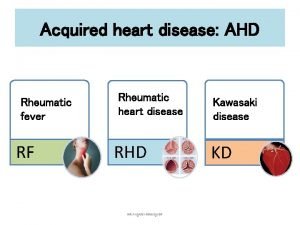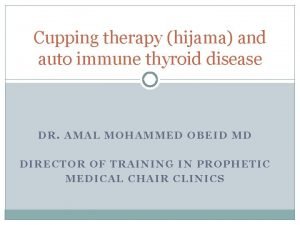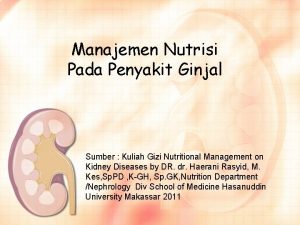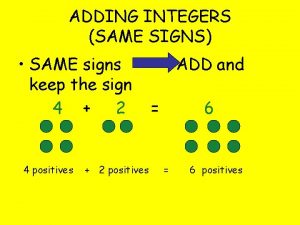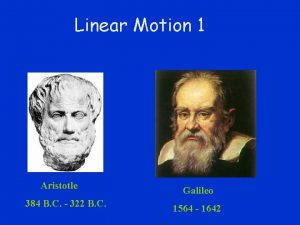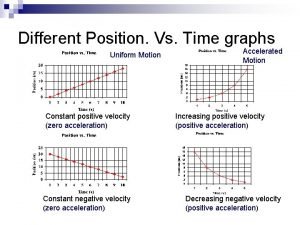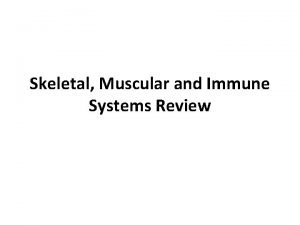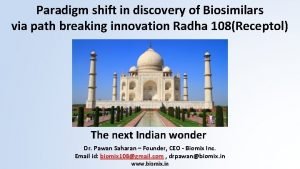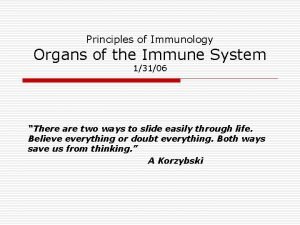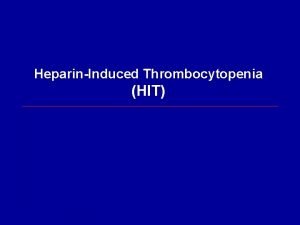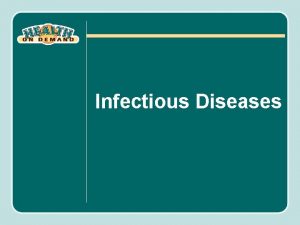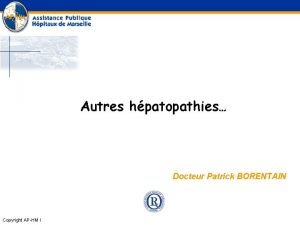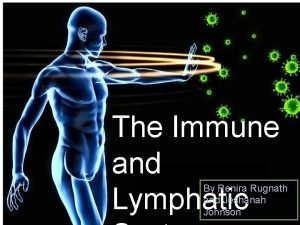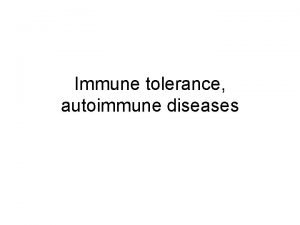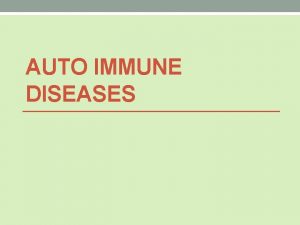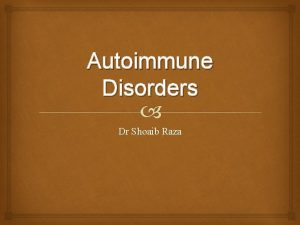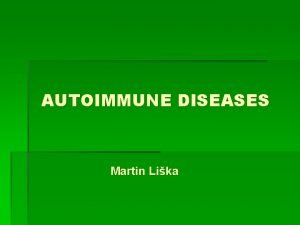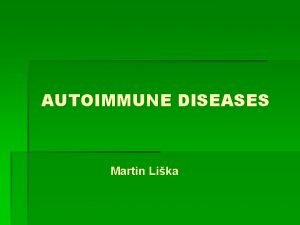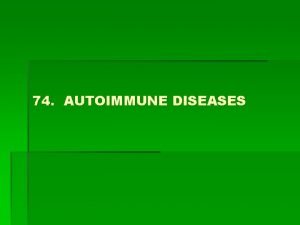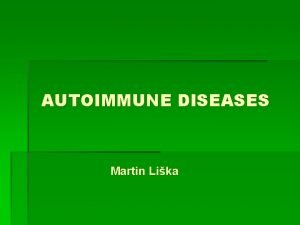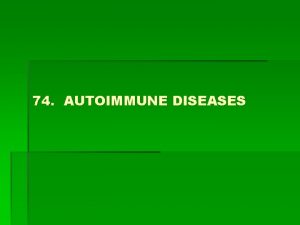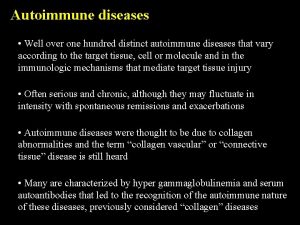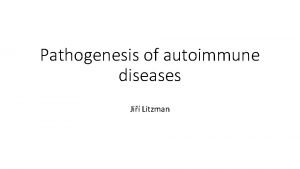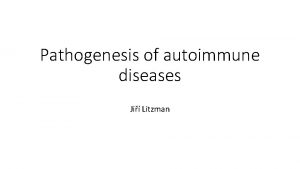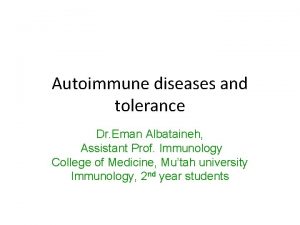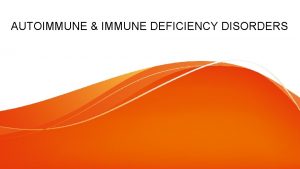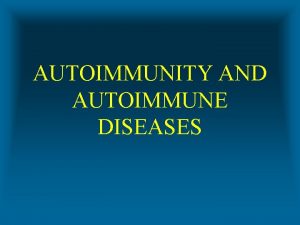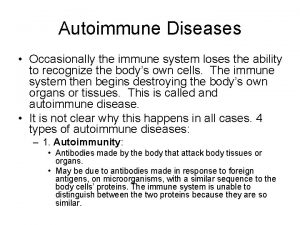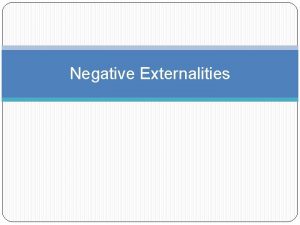Immune tolerance autoimmune diseases Immune tolerance Central negative































- Slides: 31

Immune tolerance, autoimmune diseases

Immune tolerance • Central: – negative selection during thymic education – deletion of autoreactive B-lymphocytes in bone marrow

Positive selection in the thymus

Negative selection in the thymus

Tolerance ‘Central’

Immune tolerance • Peripheral: – Clonal deletion - elimination of autoreactive cells by apoptosis – Clonal anergy - costimulatory signals are lacking – Clonal ignorance - to low concentration of antigen does not stimulate immune response – Suppression - autoreactivity is blocked by regulatory cells


Tolerance ‘Peripheral’

Regulatory T cells • Treg cells – naturally occurring regulatory cells causing tolerance of autoantinegens. They cause active tolerance of autoantigens. Development in the thymus. Involved in inborn tolerance. Also the induction of these cells in periphery by foreign antigens seems to be possible. • TH 3 (Tr 1) cells: induced in periphery. They cause acquired tolerance.

Acquired immune tolerance • Low-zone tolerance: repeated injections of very low doses of antigen. Suppressor cells are stimulated. • High-zone tolerance: induced by highdoses of antigen. Clonal deletion is induced. • Oral tolerance

Mechanisms of breakage of immune tolerance • Visualization of „hidden antigens“ • Alteration of body antigens by chemical substances, burns, necrosis • Cross reactivity of antigens • Excessive stimulation of the immune system, abnormal expression of HLA-II antigens. • Defect in suppressor function of lymphocytes

Systemic autoimmune diseases Systemic lupus erythematosus Rheumatoid arthritis Sjogren’s syndrome Polymyositis Dermatomyositis Scleroderma (progressive systemic sclerosis)

SLE • A prototypic multi-system autoimmune and immune complex disease • Involvement of skin, kidneys, lungs, heart blood vessels • Immunoregulatory abnormalities • Many autoantibodies – ANA • ds DNA • ENA – Phospholipids

Systemic lupus etythematodes (SLE) • Systemic autoimmune disease affecting various tissues and organs • Many symptoms are caused by deposition of immune complexes (type-III immunopathological reaction) • Female : male ratio is 10: 1 • Usually begins in early adulthood

Systemic lupus erythematodes Clinical presentation • • General: fever, malaise, loss on weight Artralgia Skin: butterfly rash, urticaria Vascular: Raynaud´s phenomenon Neurological: vasculitis, seisures, neuritis Glomerulonephritis Haematological: leukopenia, thrombocytopenia anemia • Recurrent serositis

Systemic lupus etythematodes • Butterfly rash

Systemic lupus etythematodes

Autoantibodies in SLE - 1 Anti-nuclear anibody (anti-nuclear factor) Indirect immunofluorescence on Hep 2 cells Staining pattern may be clinically useful Interpretation depends on clinical story, titre and age Sensitive but not specific Good screening test for lupus (prevalence ~ 100%)

Positivity of antinuclear antibodies (ANA, ANF) • • • SLE: 95 - 100 % Rheumatoid arthritis: 15 - 30 % Systemic scleroderma: 75 -80 % Autoimmune hepatitis: 20 -60 % Healthy persons: 0 - 4 % Seniors: 10 - 20 %

ANA - homogenous type

ANA – granular type

Systemic lupus erythematosus

Livedo reticularis

Systemic lupus etythematodes

Organ-specific autoimmune diseases Endocrine system Autoimmune (Hasimoto’s) thyroiditis Hyperthyroidism (Graves’ disease; thyrotoxicosis) Type I diabetes mellitus (insulin-dependent or juvenile diabetes) Autoimmune adrenal insufficiency (Addison’s disease) Autoimmune oophritis Hermatopoietic system Autoimmune hemolytic anemia autoimmune thrombocytopenia Autoimmune neutropenia Neuromuscular system Myasthenia gravis Autoimmune polyneuritis Multiple sclerosis Skin Pemphigus and other bullous diseases Cardiopulmonary System Rheumatic carditis Postcardiotomy syndrome (Dressler’s syndrome) Gastrointestina tract Atrophic gastritis Crohn´s disease Ulcerous colitis Autoimmune hepatitis

Anti- parietal cells antibodies

Pernicious anemia • Antibodies against gastric parietal cells cause atrophic gastritis. • Decreased production of gastric juice results in dyspeptic problems. • Also production of intrinsic factor is decreased causing disturbed resorption of vitamin B 12. • Low serum levels of vitamin B 12 result in megaloblastic anemia.

Anti-receptor antibodies • Stimulatory – – Graves disease. Antibodies against TSHreceptors stimulate function of thyroid gland causing hypertyreosis. • Inhibitory – Myastenia gravis. Antibodies against acetylcholine receptor block activation of muscle in neuromuslular junction.

Treatment of autoimmune diseases • Substitution of function of the affected organ (insulin treatment, parenteral treatment by vitamin B 12…. ) • Anti-inflammatory drugs • Immunosuppressive treatment • Tolerance induction

Systemic Immunosuppression • • • High-dose steroids Purine antagonists: Azathioprin Alkylating agents: Cyclophosphamide Anti-pholates: Methotrexate Calcineurin antagonists: Cyclosporine A, Rapamycin, Tacrolymus • Block of purins synthesis: Mycophemolate • Antilymphocytic serum • Monoclonal antobodies: anti CD 3, anti CD 20, anti CD 54. . .

Imunostimulatory drugs • • Synthetic immunostimulators: inosiplex Cytokines: IL-2, interferons Thymic hormones Bacterial immunomodulators: Ribomunyl, Broncho-vaxom, Luivac, Imudon, Biostim. . .
 Central tolerance and peripheral tolerance
Central tolerance and peripheral tolerance Primary immune response and secondary immune response
Primary immune response and secondary immune response Crohn's disease
Crohn's disease Beau's lines autoimmune disease
Beau's lines autoimmune disease Hijama for thyroid
Hijama for thyroid Autoimmune diet
Autoimmune diet 40h6 tolerance
40h6 tolerance Same sign keep and add
Same sign keep and add Negative velocity negative acceleration
Negative velocity negative acceleration Constant rightward velocity
Constant rightward velocity 1st line of defense immune system
1st line of defense immune system Type of muscle
Type of muscle Cellular immune response
Cellular immune response Pharyngeal tonsils
Pharyngeal tonsils Difference between innate and learned behavior
Difference between innate and learned behavior Unsaturated alcohol crossword clue
Unsaturated alcohol crossword clue Immune system lymph nodes
Immune system lymph nodes Ap biology immune system
Ap biology immune system Hit heparin
Hit heparin Immune reconstitution therapy
Immune reconstitution therapy Adaptive immunity
Adaptive immunity Flow chart of wbc
Flow chart of wbc Defination of infection
Defination of infection Immune checkpoint inhibitors mechanism of action
Immune checkpoint inhibitors mechanism of action Chapter 35 immune system and disease
Chapter 35 immune system and disease Maladie auto immune connectivite
Maladie auto immune connectivite Adcc immune
Adcc immune Chapter 24 the immune and lymphatic systems and cancer
Chapter 24 the immune and lymphatic systems and cancer Hepatite auto immune fmc
Hepatite auto immune fmc Immune system definition
Immune system definition Lymphatic vs immune system
Lymphatic vs immune system Chapter 24 the immune and lymphatic systems and cancer
Chapter 24 the immune and lymphatic systems and cancer



